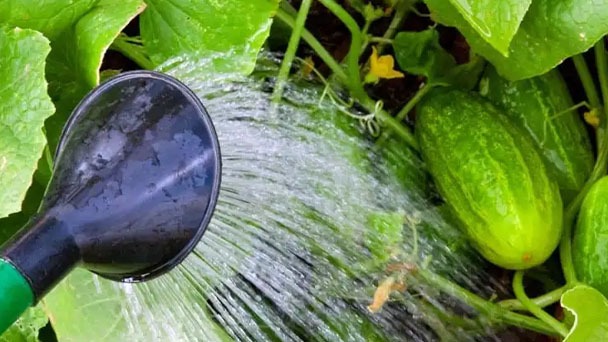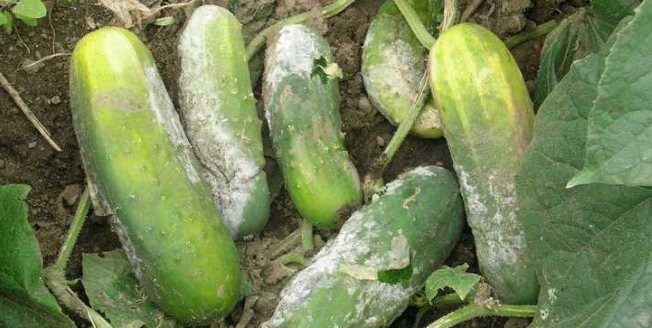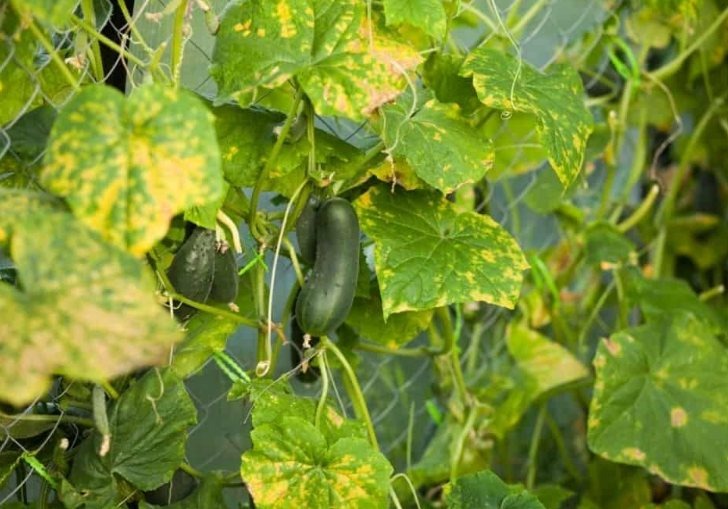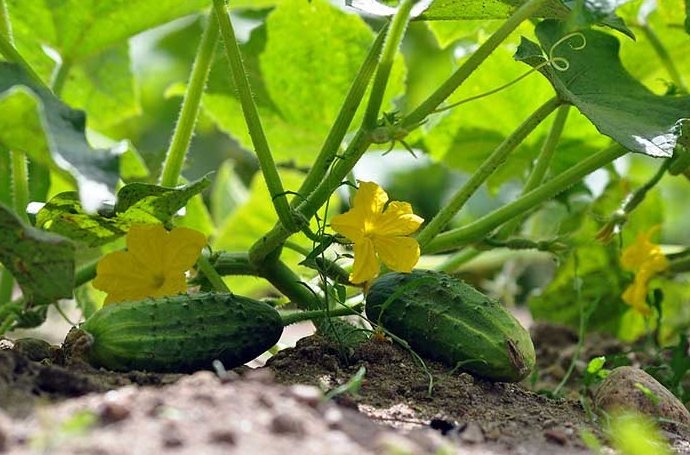Signs of Over Watering Cucumbers & How to Fix
Written by Ivy
Jan 06 2023

In this article, we will be looking at the symptoms and problems you may face when it comes to over-watering cucumbers. Also, we will be looking at how to water your cucumber plants the right way. We will also be discussing how you can correct or deal with overwatering problems you may encounter with your cucumber plants.
To fix the overwatered cucumber plant, stop watering the cucumber plant as soon as you notice the signs of overwatering. Remove the dead leaves and stems, and allow the roots to dry. Also, add mulch above the soil, which helps to absorb excess moisture from the soil.
Overwatered Cucumber Plants

Cucumbers are one thirsty vegetable which means they require lots of watering. But it is important you know how much watering to supply your cucumber plants.
Over-watering your cucumbers can be pretty detrimental to the health of the plant. When cucumber plants have been overwatered, you begin to notice some adverse symptoms.
Symptoms of Over Watering Cucumbers
The main problems faced with over-watering cucumbers include:
1. Yellowing of Leaves & Crispy Edge
When the leaves start to turn yellow, this may be an early symptom of over-watering. Once the cucumber plants sit in a waterlogged environment for a long time, they become damaged. This causes nutrient lockout where plants can't absorb appropriate nutrients. Hence, the leaves start to turn yellow.
Another common symptom shown by your cucumber leaves when they've been over-watered is crispy brown edge and tips. This is because as water is taken up by your cucumber plants, it travels through each leaf and cell to cell by the process of osmosis.
When the water reaches the outer edge of the leaves, it becomes trapped because the plant has absorbed excess water. Hence, this causes the cells on the edges of the leaves to swell and burst. Therefore, this is when you notice the dead and brown edges of the leaves.
2. Root Rot
As we said, the cucumber plant doesn't like waterlogged soil. Mostly, cucumbers grown in heavy soil such as clay soil are more prone to water retention rather than draining. It helps to add humus materials like decomposing straws or leaves to enhance drainage.
When the roots sit too long in a waterlogged environment, it predisposes them to fungus problems. This in turn causes root rots and affects the absorption of nutrients and oxygen.
The bad side of this is that if the whole plant system has been affected, it may be impossible to save the cucumber plant. Hence, it's advisable to remove and destroy the whole plan.
However, if the damage is minor, you may possibly save your cucumber plant by replanting in new soil with proper drainage. Saving the cucumber plant will depend on the type of fungi the plant has been infected with.
3. Powdery Mildew
Watering your cucumber the wrong way such as overhead watering can predispose them to powdery mildew. Powdery mildew is a common fungi infestation.
Cucumber plants infected by powdery mildew tend to show spots on leaves. These spots may spread to the stem and fruits. With time, the leaves begin to wilt, turn brown, and fall off. Therefore, this leaves the cucumber plants exposed to the sun.
When the infection is serious, it results in small and deformed cucumbers. However, this infestation can be easily treated if you notice them early.
Treat with a natural anti-fungal spray such as neem oil.
How to Save Overwatered Cucumber Plant?
It hurts to see your houseplants suffer, especially when you realize you are harming them unintentionally with the wrong growing techniques.
If you become conscious at the early stages, your overwatered cucumber will recover after ten to fourteen days.
Hence, take the following steps immediately after noticing the overwatering signs.
- Firstly, stop watering the cucumber plant as soon as you notice the signs of overwatering. But if the soil 2-3 inches below is dry, water the plant with a relatively small amount.
- Remove or prune the yellow leaves, dead stems, and affected roots with a sterilized knife. This will help preserve the nutrients for the healthy parts.
- If the roots are too wet and decaying, you can add humus materials to improve drainage.
- Expose the cucumber roots and allow them to dry in an absorbent material like a paper towel overnight.
- After the roots dry, cut off the rotten roots and transplant them into healthy soil.
- Move the overwatered cucumber plant to a shady location.
- If the soil is too damp, replace it with a mixture of well-draining potting. Sand will be the perfect factor to increase drainage.
- Add mulch above the soil so that it will absorb the excess moisture from the soil.
How Much Water Do Cucumbers Need?

Watering cucumber plants the right way is the key to having a healthy and thriving plant. Cucumber plants are to be watered less in cooler spring temperatures when they've been planted first. They will require more watering once their growing season takes off.
So, here are some ways to watering your cucumber plants appropriately:
- Water your cucumber plants only when needed. Watering should be done preferably in the morning so any excess water in the soil or on the leaves can evaporate off during daytime heat.
- Water your cucumber once or twice weekly and the watering should be 1 or 2 inches deep. 2 inches dept watering is ideal for dry weather.
- Before you water again, always check the soil if it's still moist by digging 1 inch deep. If you notice the soil is still damp, don't water. Keep checking the soil every day until the soil is almost dry and you can water again. Stop watering when you see the upper part of the soil is damp.
- The soil should be mulched with straw or wood chips as this helps reduce evaporation. Hence, less watering will be required.
- Avoid overhead watering. Watering should be done at the ground level of the soil. This way, the leaves of the plants can dry out completely to avoid fungi infestation.
- Cucumbers grown in containers should have big drainage holes to ease water run out.
How Often Should Cucumbers Be Watered?
Only water cucumber plants as needed. Watering in the morning allows excess water in the soil or on the leaves to evaporate during the daytime heat.
Water your cucumbers once or twice a week, 1 to 2 inches deep. In dry conditions, 2-inch watering is good.
Dig 1 inch deep into the soil to see whether it needs more water. Don't water if the soil is still wet. Check the soil daily until it is almost dry and you can re-water. Stop watering when the soil is wet on top.
Mulching the soil with straw or wood chips helps minimize evaporation. Less watering is required.
Avoid overhead watering and watering should be done near the soil's surface so the plants' leaves can dry completely and minimize fungal infection.
For container gardening, large drainage holes are required.
Can You Revive a Dying Cucumber Plant?
To revive a cucumber plant with dying cucumbers, do the following:
Maintain a healthy level of nitrogen in the soil.
Increase the amount of water that has sufficient oxygen for plants to survive.
If cucumbers develop wilting leaves after being transplanted outside because of a lack of potassium, put more potassium-rich soil around the roots.
Cucumber plants can be revived in a variety of methods. If your cucumber plant is wilting or discolored, use the following steps:
- Keep cucumbers well-watered and in well-draining soil.
- Move cucumbers to a location where they will receive enough sunshine but not direct sunlight to meet their demands.
- To avoid spreading illness among your cucumber plants, remove any unhealthy ones from your yard.

Tips to Prevent Overwatering in Cucumber Plant
You need nothing but to adopt the correct watering schedule to avoid harm to cucumbers due to overwatering.
It would be best if you supplied an inch of water weekly to the cucumber plant. If you live in a hot area, elevate the quantity to 2 to 3 inches a week.
Other than this, there are some other tips you can follow to water your cucumber plant properly.
- When watering a healthy plant, water it only if the soil is dry one inch below.
- As days are shorter in autumn, your cucumber plant needs less water during this season.
- Do not water your cucumber plant overhead. Instead, water the plant from the base until one to two inches of the soil is dry.
- During summer, run the soaker hoses to the roots of cucumber plants for 5-10 minutes.
- Choose a well-drainage soil such as sandy or loamy potting mix for your cucumber plant. If the soil is clayey, you must add compost or perlite to enhance the drainage.
- Water the cucumber plant in the morning, enabling the roots to absorb moisture before day heat.
- Use a soil moisture meter to check the wetness of the soil.
- It is also better to use a drip irrigation system as it provides water directly to the soil.
FAQs
How Do You Fix Overwatered Cucumbers?
Over-watering your plants is one of the most common mistakes gardeners make. It's easy to get it wrong – sometimes it can even be difficult to spot.
Overwatering causes excess moisture in the soil Soil doesn't drain properly How to tell if a plant needs water. Soil moisture levels vary throughout the growing season. In early spring, you'll need to water your plants to maintain good soil moisture levels for healthy growth. During the summer months, you'll need to water less frequently to avoid overwatering. Over winter, you'll need to keep your plants watered so they can survive through the dormant period until next year.
When the plants start to wilt, pull them out of the ground and place them in a bucket or container with a drainage hole. Give them a good rinse and check their roots for damage. If they have any roots that are brown or mushy, pull them out. You don't want to damage the roots when you repot. If they are too large, cut them into smaller pieces and transplant them into larger containers.
What Does An Overwatered Cucumber Look Like?
The cucumbers will still grow and produce, but the cucumbers will not look great. Overwatered cucumbers are green, have a wrinkled skin, and sometimes even the leaves turn brown or yellow. When the soil is very wet, the roots are able to take up nutrients, but not air. As a result, the leaves become brown and start to droop. This is because the roots are unable to transport enough oxygen into the plant.
- Read More: Why Your Cucumber Leaves Are Turning Yellow
How Often Should Cucumbers Be Watered?
Cucumbers are among the most productive and easiest vegetables to grow. Cucumber plants need water to stay healthy and grow properly. It is important that you water your cucumber plants regularly. Cucumber plants love moist soil and will produce a ton of fruit if you give them enough water. Cucumber plants can survive without much water, but they will not grow or produce as well.
You can water your cucumbers every two days to keep them happy and healthy. The best time to water your cucumbers is in the morning before they go into the sun. This is when they get their daily dose of light, but do not get too much water at once. If your soil is dry, it will cause your cucumbers to grow slowly and become spindly.
Do Cucumbers Like Wet Soil?
The answer is yes. Cucumber plants need to be well watered, especially during the hot summer months. In fact, the best time to water your garden is after a rain or two. This will not only give your plants a drink, but it will also help the soil retain moisture. If you have a lot of cucumber plants, it may be a good idea to keep a hose around the garden to water the plants as they need it.
Cucumber plants are very easy to grow. They are one of the easiest vegetable plants to grow in your garden.
Should I Cut Off Yellow Cucumber Leaves?
If the leaves of your cucumber plant are yellow, it could be a sign of a nutrient deficiency. Try fertilizing your plant and see if that makes a difference. If the leaves are still yellow after fertilizing, you can try trimming them off.
Final Words
Cucumbers are water-loving or thirsty plants. But that doesn't mean we should over-water them. Over-watering cucumbers can predispose them to root rot, yellowing of leaves, crispy edge on the leaves, and powdery mildew.
Latest Updated
- Benefits of Bugleweed - 7 Science-backed Health Benefits
- Bugleweed Dangers & Side Effects - Is It Poisonous?
- How to Plant Evergreen Trees - What You Should Know
- When to Plant Evergreens - Grow Guide for Evergreen Trees
- 12 Wonderful Evergreen Shrubs for Your Garden
- 12 Popular Evergreen Plants with Pictures for Beginners
- When And How To Prune A Lilac Bush Like a Pro
- How to Grow & Care for Lilac Vine (Hardenbergia Violacea)
- Japanese Lilac Tree (Syringa Reticulata) Care & Propagation Guide
- Shumard Oak Pros and Cons - What to Know
Popular Articles
- Winter maintenance of Antirrhinum Majus
- How to Grow Terminalia Mantaly Tree
- How to Grow and Care for Crossostephium Chinense
- How to grow Antirrhinum Majus in spring
- Peristeria Elata (Dove Orchid) Profile: Info & Care Guide
- Underwatered Snake Plant (Sansevieria Trifasciata) - Signs And How To Fix
- How to Care for Brazilian Jasmine Plant (Mandevilla Sanderi)
- How to Grow & Care for Graptopetalum Purple Delight in Summer
- Rosa Chinensis (China Rose): Plant Growing & Care Tips
- How to Care for Baby Sun Rose (Aptenia Cordifolia)